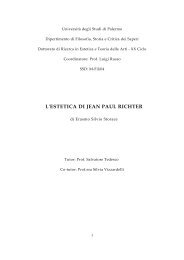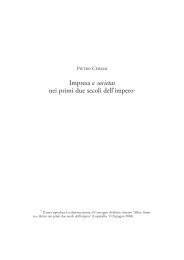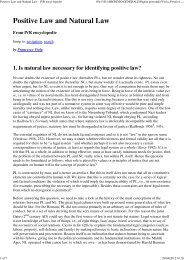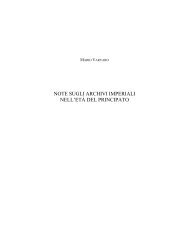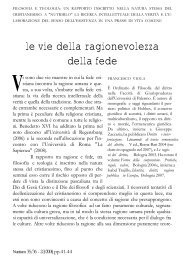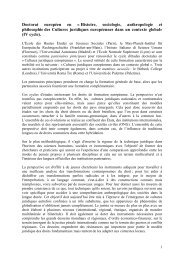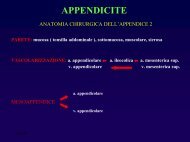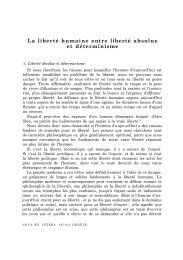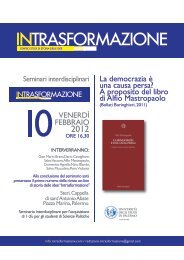Capitolo 17 – Le Vibrazioni Meccaniche
Capitolo 17 – Le Vibrazioni Meccaniche
Capitolo 17 – Le Vibrazioni Meccaniche
You also want an ePaper? Increase the reach of your titles
YUMPU automatically turns print PDFs into web optimized ePapers that Google loves.
700<br />
CORSO DI MECCANICA APPLICATA ALLE MACCHINE<br />
( r)<br />
a<br />
<br />
= ρn<br />
() t<br />
a =<br />
( c)<br />
a =<br />
<br />
r + − +<br />
<br />
ω+ ϕ k ρn =<br />
r +<br />
ω+ ϕ<br />
<br />
n<br />
<br />
ρτ<br />
( 0 ρϕτ ) ( ω<br />
2<br />
ϕ 2)<br />
( 0 ρ)<br />
2( ) Λ<br />
2(<br />
) <br />
2 2<br />
Ora, nel componente tangenziale della a (t) si può trascurare ρ rispetto<br />
ad r0 , e si può trascurare anche, nel componente normale, il<br />
termine che contiene ϕ 2 , essendo quest'ultimo certamente piccolo<br />
rispetto ai termini che contengono la ω.<br />
Pertanto l'espressione dell'accelerazione diventa:<br />
2<br />
<br />
a ≅ ρn+ r − ( + )( r + ) n+<br />
( + ) <br />
0ϕτ<br />
ω 2ωϕ2 0 ρ 2 ω ϕ2 ρτ ≅<br />
2 <br />
≅ ρn+ r − ( r + ) n− ( r + ) n+<br />
+ <br />
0ϕτ<br />
ω 0 ρ 2ωϕ2 0 ρ 2ωρτ 2ϕ2ρτ<br />
≅<br />
2<br />
<br />
≅ ρ− ω r + ρ − 2ωϕr + ρ n+ rϕ<br />
+ 2ωρ+ 2ϕρτ<br />
<br />
[ ( 0 ) 2( 0 ) ] [ 0 2 ]<br />
e in questa si può ancora trascurare ρ rispetto ad r0 , nel termine<br />
del componente normale che contiene il prodotto ωϕ 2, mentre,<br />
nel componente tangenziale, si può trascurare il termine 2ϕ 2ρ.<br />
Rimane, in definitiva:<br />
2<br />
<br />
a ≅ ρ− ω r + ρ − 2ωϕr n+ rϕ+<br />
2 ωρτ <br />
[ ( 0 ) 2 0] [ 0 ]<br />
Questa accelerazione genera, su ciascuna delle due masse mobili,<br />
una forza d'inerzia il cui risultante è:<br />
m m 2<br />
<br />
F'=− ma =− [ r ] [ ( r ) r <br />
0ϕ+<br />
2ωρτ+<br />
ω 0+ ρ + 2ω<br />
0ϕ2 −ρ<br />
] n<br />
2<br />
2<br />
per cui il lavoro complessivo di tali forze (per le due masse) è:<br />
2<br />
( ) ( )<br />
[ 0 0 2 ]<br />
δL'=− m rϕ + 2ωρrδϕ + mω r + ρ + 2 ωrϕ− ρδρ<br />
0 0 2<br />
cui è da sommare il lavoro delle altre azioni attive e reattive, ossia:<br />
[ M K( ) J ]<br />
( Ω ) ( )<br />
k ( r l )<br />
δL1 = − 0 − ϕ1 −ϕ2 − 1ϕ1 δϕ1<br />
δL2 = [ M0 + M1cos t − K ϕ2 −ϕ1 − J2ϕ<br />
2] δϕ20<br />
1° vol.<br />
2° vol.<br />
δL =− + ρ−δρ m mob.<br />
3 0 0 0<br />
Il lavoro complessivo sarà allora:



